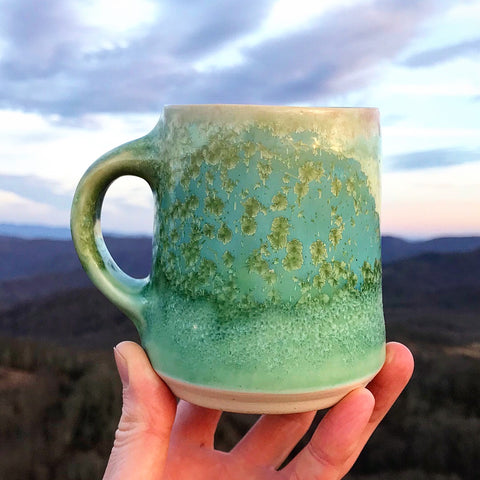Crystalline glazes have been an obsession of mine for quite a while. I think obsession is the right word, sometimes I say I'm fascinated by them but that's really too mild a way to talk about something I've spent probably into the thousands of hours studying, and I can bore some folks real fast if I get going talking about glaze chemistry. These are glazes in which, at high temperatures in the kiln, minerals crystallise through the molten glass coating the pot.

Willemite is the most common mineral to grow in a glaze. It's what I named my lil business after, which at the time I thought was a great idea, nerdy I know, didn't occur to me the name is hard to spell and hard to remember, and that people would think my name is Will, damn.

Anyway Willemite is popular as far as crystalline glazes go because it grows faster and slightly more reliably than other crystals, and can be coloured in an incredible variety of ways by adding small amounts of metals such as Iron, Titanium, Cobalt, Copper, Manganese, Nickel and other metals. Some folks even add Gold and Silver, and some materials that are quite rare for artists to use such as Neodymium, Bismuth, and even Uranium.... Uranium by the way gives bright yellows and possibly oranges or reds, it makes the glaze glow under UV, it'll definitely set off a geiger counter, and may well scare your friends away from you. This is just what I've heard, I wouldn't mess with it, and besides yellow glazes are easy to achieve without Uranium, we can get yellows using Iron or Cadmium or Praseodymium or Titanium so, no shortage of yellow possibilities.

"Chatoyancy" is a term used in gemology to describe the tigers eye effect in a gemstone, if you're not familiar with the stone Tigers Eye, it has a shimmering effect in the reflecting light as it is moved around. This chatoyancy is very common in crystalline glazes, it shimmers in the light nothing like the boring refraction of a normal glossy glaze.

These glazes start as a very specific mixture of crushed up minerals, such as clay, feldspar, quartz etcetera. These are mixed with water to make it easier to apply to pottery by dipping or painting or spraying. I fire 'em to 2,200 Fahrenheit at which point they're a fluid molten glass with no crystals yet. Then slowly cool the kiln, and as it cools crystals begin to precipitate from the molten glass. They grow between about 1700 to 1900 Fahrenheit, and depending how the kiln cools through that range can change shapes and colors of the crystals. Going too much above 1900 at this point will make the crystals dissolve back into glass, and going much below 1700 the glaze will solidify too much for crystals to continue growing.

The glaze without these colorants is typically a clear glass with translucent white crystals. Depending on how the glaze is cooled Willemite crystals can form circular crystals, or ginkgo leaf shapes, starburst shapes or sharp needle shapes. And by repeatedly heating and cooling the kiln it's possible to grow agate-like tree ring shaped crystals, often with multiple colors showing off the different bands grown at varying temperatures.

That idea of forming tree-ring-like bands is what first got me into crystalline glazes. During my final year in college back in 2013 I was making a series of leaf sculptures. Like, giant ceramic leaves that were sorta inflated looking to look like they were breathing, as well as leaf sculptures that stood on their stems like a tree. So as I was making a small forest of these I was thinking about using this crystalline glaze to get green and brown glazes with agate like tree ring formations, though I didn't realise the massive amount of glaze chemistry I was about study. While at Alfred University my Glaze Chemistry professor was Matt Katz who is notorious for getting his students hooked on crystalline glazes, since graduating I've taken a couple more of his courses online, so yeah if ya wanna learn glaze chemistry check out ceramicmaterialsworkshop.com and probably stock up on Zinc Oxide while your at it. It was shocking how Matt can get someone to flip from "I need to develop a glaze to suit this piece" over to "I need to develop a piece to show off this glaze"

After graduating I started experimenting with Sphene crystalline glazes. Willemite is a Zinc Silicate mineral that often forms round shapes, while Sphene is composed of Calcium Titanium and Silica and forms more angular shapes, and has really great chatoyancy.

Molybdenum crystalline glazes still elude me, these form Powellite, a Calcium Molybdate crystal, and they can form large iridescent fractal fern shapes, as well as triangles and star shapes. I've had some work on occasion but not much luck considering the countless tests I've tried.

Aventurine glazes are another type of crystalline glaze which have much smaller crystals, typically of Iron, these glitter because the little Iron crystals sparkle in the light. The "Hematite" glaze I use on my jewelry is an Aventurine glaze I developed.

And the "Obsidian" glaze I use on jewelry is another type of crystalline glaze, which forms a mineral called Tephroite, a Manganese Silicate. This one is subtle and dark right now, but I haven't even scratched the surface of its potential, with some very small subtle tweaks to it's chemistry it could go from dark and subtle to, well, maybe that should stay a secret for now.


2 comments
Great article, thanks!
Wondering if one can add simply willemite to an existing glaze for an effect or if one has to measure out a new glaze recipe.
Hi Evan
Cool stuff, I’m exploring ceramic techniques, especially crystal-stuff, in much the same way as you do. I’ll add you friend on fb if you don’t mind or we could connect otherwise.
Greets
Mathias Mark Sanderson